PRE2017 1 Groep1
| Members of group 1 | |
| Bern Klein Holkenborg, Mechanical Engineer, 0892107 | |
| Sjoerd van Heesbeen, Mathematician, 0917699 | |
| Luke van Unen, Software Scientist, 0897537 | |
Introduction
In this project, problems are solved with a societal perspective. Engineers usually look at problems from their perspective, easily overlooking that the problem they are solving might not connect with the people they are solving them for. Or the solution proposed may solve the problem in a way where the user is helped but in an inconvenient or uncomfortable manner. In this project we explore the adaptation of just that: looking for the user's need. In this project, a robot is suggested to ease police work, as well as making the work safer for both police and civilians.
Problem Definition
Objective
To keep up with the growth in population and changes in our society, the police force has the opportunity to evolve into a partly automated force. The objective for the project is to help envision part of this process. A robot should be created to automate an otherwise employee intensive or dangerous police task. Without bringing user or society at risk. The robot should be safe to interact with, useful and be able to cope with every situation it faces. There are already "real" police robots providing assistance to citizens (Dubai). However they are often lacking in most capabilities compared to human officers. The scope of the project would be far too great to design such a complete officer replacement robot. Instead in this project we will try tackling a specific police task. Some examples of such a tasks would be: Speeding control, a mobile robot could check wherever, whenever for speeding cars. Or an automated alcohol check, a robot could be set up to automatically check if a driver is allowed to drive or not. Or a robot that monitors a vehicle chase, a mobile robot unit might be faster, cheaper and more versatile than a police helicopter. Discussing these options, we saw the greatest opportunities in designing a robot to help in riot control. Riots are labour intensive, police officers are subjected to agressiveness, violence and physical and mental wear. Another problem is that usually both police, and rioters are harmed by riot violence.
Approach
To tackle a these problems, we investigated how and why this police task is performed and how this could be improved upon by utilizing robots. We researched crowd theory, state-of-the-art and interviewed a peleton commander of the dutch riot control. We set up requirements for the robots based upon the findings. Having our requirements, the project goal was narrowed down as designing the complete robot would be too extensive for this project. A small part of the design was chosen to elaborate, this part was worked out in the last weeks of the project. A design is suggested for the robot's decision making in form of both a flowchart diagram. A finite state diagram is made to explore failed state feedback loops. Finally a concept user interface is made to control the robots. The design of these was based on the set requirements, and use cases that the robot should be able to handle. The design was evaluated by theoretically handling the use casese. Also stakeholder feedback was given by the peleton commander. Finally a conclusion is given and suggestions are done for further research.
Crowd Theory
To start of we explored theories on how crowds function. There are several different psychological theories on crowds. Some of which are Gustave Le Bon's theory, Sigmund Freud's theory, Ralph Turner’s theory, Henri’s Tajfel’s theory, and many others. Each of these theories have a different perspective on the psychology of a crowd and its members. It is important to look at these theories when designing a crowd management solution. The psychology of a crowd tells about the interaction between individuals, thoughts of the masses and tells about the (unpredictable) actions of these crowds. Knowing the inner processes of a crowd explains the origin of all kinds of problems within a crowd, such as uproar, violence, mass rallying, panic and so on. Therefore theories mentioned earlier will be looked into, to investigate why or where a robot can best help interacting with and managing a crowd.
Irrational theory
First Gustave Le Bon's Theory is looked into. Gustave Le Bon wrote ‘Mind of the Crowd’ and with that started the psychology of masses department in psychology, which now-a-days branches to politics, conventional and social media and many other. In this ‘Mind of the Crowd’, Le Bon argues that individuals are no longer themselves. Would an individual been alone, he would kept himself under restraint. Le Bon says ‘he is no longer conscious of his acts’. His argument is that a crowd is irrational. It does not think for itself, it only acts. An important quote from his work: We see, then, that the disappearance of the conscious personality, the predominance of the unconscious personality, the turning by means of suggestion and contagion of feelings and ideas in an identical direction, the tendency to immediately transform the suggested ideas into acts; these, we see, are the principal characteristics of the individual forming part of a crowd. He is no longer himself, but has become an automaton who has ceased to be guided by his will.
In other words, rationality translates to irrationality by contagion of feelings and ideas in identical direction. And irrationality leads to immediate acting upon ideas, thus the individual started being an actor incapable of reason instead of a rational being.
Although in the 1960’s the theory of irrational crowds was widely rejected, now-a-days this theory is taken in consideration again in some behalf. Take the Burnley Riots in England 2001. Young people were discontent about their living conditions. There was unemployment, poverty, crime and other conditions. In 2001, these youngsters started looting shopping centers and setting cars alight. Initially, law enforcement tried to communicate with the rioters, however soon noticed the riot and its members were irrational, and in no way able to negotiate. Homes were petrol bombed, families were attacked, and law enforcement officers were assaulted. Petrol bombs, stones and other projectiles were hurled at the police. People joined the riots just to loote or for some sensless violence. The riot eventually caused over 300 officers to be injured. Here we wonder how robots could have helped the law enforcement. A mobile barrier between rioters and law enforcement could possibly have prevented injuries on both sides, and could have created safe areas in critical zones. Robots could be providing a versatile shield for the officers to displace the crowd. Robots could even hypothetically have acted as riot control units when equipped with water guns, but this is out of our current scope.
Secondly, Sigmund Freud’s theory. Sigmund Freud is a well-respected psychologist who published ‘Group Psychology and the Analysis of the Ego’ in 1921. In fact, this is the base for his most famous published work ‘The Ego and the Id’. In his ‘Group Psychology and the Analysis of the Ego’, Freud also argues that the individuals in large groups form an irrational crowd acting on suggested ideas. However, the reasoning is different. Freud suggests that the so called ‘super-ego’, the part of the ego that is conscious and responsible for our inner reasoning is overthrown in a group. The intensification of emotion in a group by contagion is not accounted for by the super-ego. Freud argues that through a crowd, the super-ego’s restraints on a person’s behavior is minimalized and these restraints are replaced by impulses from, for example a charismatic crowd leader creating simple emotions instead of complex ones, as simple ones are easier to interpret for the restraint super-ego. This is for example how dictators like Hitler manipulated crowds he believes. The difference here between Le Bon and Freud is that people not merely stop thinking, but are overwhelmed in contagious emotion. Though the conclusion is similar, the individual starts being an actor incapable of reason instead of a rational being. Because the conclusion of this theory is the same, the same principles can be applied for using a robot riot support unit. One note on that however, Freud suggests that charismatic leaders have an extra effect on the actions of a crowd. Identifying and recognizing these individuals would be an almost impossible task for robots. However the robots cameras can provide a safe view of the crowd so that officers can safely assess which people are instigating violent behavior and single them out.
Emergent norm theory
Although Le Bon and Freud argue for an irrational crowd, Ralph Turner argues for a largely rational crowd. He published his ‘emergent norm theory’ just after Freud’s theory. He argues that people initially, in all types and sizes of crowds, do not know how to behave. Because social interaction, people start behaving like the norms of people around them. Important is that this, in contrary to the other theories, makes this crowd theory dependent on situational factors. Essentially Ralph Turner argues that social order and rationality guide behavior. This means that still, charismatic leaders will create norms that guide crowds, however these norms might not be acceptable for the individual in the crowd. The norms formed by the individual can be explained by anonymity, stimulation, emotion, contagion, legality and much more. Modern individual theories like Henri Tajfel’s social identity theory argue that individuals are not guided by the crowd, but by norms set by their social identity. This means that individuals are dictated in their morals and norms by groups to whom they are primarily are related to. These can be religious, cultural, politically or any other form of group that sets morals and norms. This way crowds are more versatile than in other theories. This theory argues that because of these crowds formed by social identity, people feel united, have a high self-esteem and have pride for this group. This causes prejudiced views of other groups or non-members, and depending on the groups moral/norms, can cause violence or other problems. This theory argues that also, crowds are largely irrational, since the prevailing cause of action is the norms set by a group. To illustrate these two theories, take the Baltimore 2015 riots. The Baltimore 2015 riots came about when Baltimore Police arrested Freddie Gray. Gray died from injuries to his neck and back, caused by his arrest by 6 officers. His arrest caused uproar in the black Baltimore society. Why this riot is interesting is because the stages of escalation. First peaceful protests were held against police violence. Peaceful norms were abided. However, more people joined the protests, and naturally the occasional arrests were made. Some protesters started harassing police offers, and later many followed. A new norm was set by the crowd, in which emotion, contagion and anonymity played part. The protests intensified because of the fact that Freddie Gray was black, which many protesters identified with. Finally a full scale riot happened with over 200 fire incidents to houses and vehicles. Also many looting occurred. In the end, thousands of officers were deployed to contain the riots, and resulted in many police injuries. Again, a mobile barrier and additional information could have prevented looting, fires and injuries from happening. It wouldn’t have prevented the riot from happening, but it would have contained the damage it has done.
Interpretation
Concluding from these theories you can observe that some riots can be prevented. Some through communicating with the disgruntled mass and picking out the people that are influencing the crowd in a negative or violent way. Still there will be some situations were a riot cannot be prevented and there is a chance for robots to have a mitegating influence on the violence. When analyzing the theory's, it becomes clear the crowd starts as a heterogeneous whole where people are not breaking the law. They are not throwing any rocks and projectiles at the police, but after a while some aggressive minority gets the overhand and will change the crowd to a homogeneous one. This crowd looks for violent altercations with the police, resulting in injuries on both sides. This is where the robots come in, first of all a robot cannot be injured. It can only be broken but unlike a human it can useally be repaired. Next to that the robot can act upon changes in their surroundings in swift unison, as they make decisions based on joint data in a more connected manner then humans can. Yet the robot will not be there as a replacement of the current M.E. officers, they will be a tool used by the police to support them. So human police officers must be present to instruct the robots and are free to perform there duties like making arrests and providing support. The robot providing them protection from some dangers, so the risk of getting harmed is decreased. Another advantage of robots over humans is that robots can not loose their 'cool'. While humans need to respond to violence, robots can keep doing what they doing, resulting in less victims at the crowd side.
When thinking of this problem and the solution we think is best, there is also the thought of a device controlled by humans, for example a bulldozer with a shield upfront, it is a lot easier to make and will have the same effect on first sight. But there are some things that cannot be done by such a machine or humans. The advantage of robots is they are all single-controlled, every robot can do his own action, yet still be connected to the larger whole. So when encountering an obstacle, the robot is able to find a way to avoid it. After which the robot can communicate and make decisions about the movement of the group a lot faster than humans can. Because of this communication, the robots can attempt to make a plan of action as accurate as possible together. Furthermore, the robot can help by picking out the black sheep in the crowd by monitoring them an making way. Resulting in officers being able to arrest them. So all by all robots could definitely impact riots positively, they could possibly lower the chance of escalation, but most likely lower the chance of damage and injury. This will eventually become clear in the process. A robot that could act as barrier, riot control unit or information system can definitely prevent harm to police, and thus also to rioters and non-partaking individuals.
Scenario
Current practice
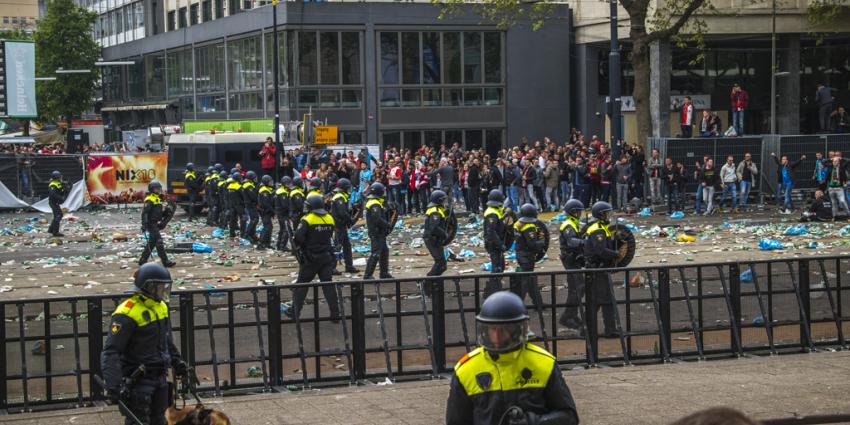
An example of a predictable riot is what happened in Rotterdam at the 7th of May 2017 when soccer fans turned against the police when their team did not win the match to secure the Dutch championship. Police forces were prepared and on standby to secure the sites were the disgruntled fans had gathered and forcibly did so making many arrests in the process. Even though the clearing of the Stadhuisplein went over quite well officers were pelted with bottles and rocks and hooligans where forcibly removed creating a situation where officers, bystanders and the culprits of the violence were all at risk. There is some video material of violent hooligans being driven away, where M.E. officers need to utilize violence to move them. This takes time while police lines shift forward all the while angry fans release their frustration upon the officers. A this stage communication has broken down and violence could potentially escalate. After some time the officers and their colleagues on horseback ended the altercations after about a hundred arrests were made. In the end manier culprits got community service punishments to make amends for the damages and harm done to the officers.
Ideal solution
Because of the knowledge of the locations where the fans will meet to watch a match a response is prepared in advance. Officers are placed nearby these locations and if altercations arise they are sent in to clear the areas where violent masses have gathered, breaking them apart and moving them away. But because officers are not made of metal advance is usually slow, dangerous. All the while violent culprits only get more chances to release their anger upon the officers. In our ideal situation the front line of shields is supported by robotic units. The robots are deployed nearby in advance in unison with officers to be ready when needed. These robots are moved on command by the officer in charge and are capable of moving the crowds in the same way a line of shielded officers would. With the advantage of the robot not feeling pain or needing to protect its body from harm like an officer needs to. Having a sturdy robot get hit by a bottle or fireworks may not only protect officers from bodily harm but is also less likely to give the adrenalin junkies among the crowd the same satisfaction thus breaking part of the crowd’s intent for engagement. The robots are thus filling a more dangerous position while officers can focus on other tasks like apprehending violent offenders trying to take out the worst elements of the crowd. So while the robot steadily advance officers can focus on the more difficult tasks hopefully enabling a steadier advance compared to when they also have to look out for their own and their colleagues’ safety. Because of the swifter action less constant violence can be applied to the crowd thus defusing the situation even further. In this scenario the quicker advance would leave less time for property or personal damages to befall. And in an ideal scenario it would be so that such a riot is no longer seen as an opportunity to fight the cops and thus become less attractive for manier violent elements all together.
Deliverable
Now the problem is stated, a target has to be set for us to work to. This target has to be concise, clear and measurable. The target for this project will be to deliver a robot design that reinforces the police force during riots. For the design, requirements are set for the robot, as well as constraints, as to make sure the feasibility of this project. Our deliverable will consist out of an elaborate list of requirements; a part of the design worked out and a validation of our concept by the police and the requirements we set.
Firstly, the target has to be concise, clear and measurable. What is meant with this is that the deliverable will be designed to a set of design goals that clearly state each individual function and capability it has to adhere. Also it is stated which functionality will not be possible or wished. The goals have to be not only clearly stated, also they have to be measurable. To be concise in your goal, a numerical value has to be attached to you as to define when the goal is met or not. It can also then be easily evaluated if the design goal was too high of a standard, or too low. This evaluation can then be taken in account for the next project.
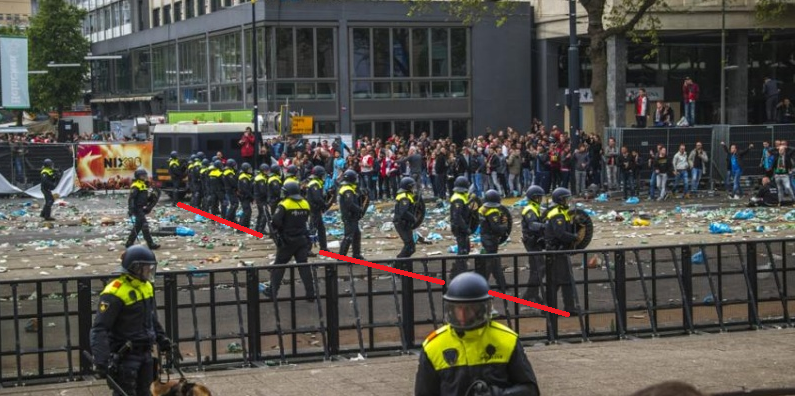
As for our target, in this project we opt for a robot design that reinforces police officers in riot situations. This however is very broad, thus the functionality has to be specified. As stated in the problem description, officers equipped with full body protection, shields and batons stand in line, forming the front of conflict as can be seen in the figure 1. They themselves form the barrier that contains violence, and come in direct contact with this violence. Is this nowadays really still necessary you could ask? This projects design goal would be to replace these human officers with robots, as to have a mechanical initial barrier, instead of a human one. These robots will communicate together to form a solid barrier. These robots will be instructed by police where to go, however the robots will operate this order themselves. The robots will navigate his route, whilst able to hold formation. It will be able to overcome obstacles (of specified proportions stated in the requirements) and know when to navigate around the obstacle. The robot will be constructed so that it is stable and hard to knock over. The robot will be able to withstand significant projectile impact, like bricks or petrol bombs. Should a robot be incapable of moving because of it is knocked over, or destroyed, the managing officer will be notified by the robot. The robot will also prevent itself from doing serious human harm. The robot can communicate with the crowd via speakers. With these functionalities, the robot will be capable of being an initial barrier between law enforcement and the violent crowd. This barrier will prove to be safer for both police and crowd. This is however further explained in the validation of our concept.
To make these functional requirements measurable, requirements are set. Also constraints are given to make sure the design is mechanically feasible.
Requirements
- Movement and stability
- The robot has the ability to move forward and backwards.
- Note that for stability, the robot will be rather heavy.
- The robot has the ability to make zero radius turns.
- Being able to move anywhere from any position can be crucial for keeping formation
- The robot has the ability to reach 10 kilometers an hour.
- This is two times the average speed of human walking. In most situations, the robot will move at less than walking speed, however, in some situations it might be required to charge.
- The robot has the ability to climb obstacles of 30 cm high.
- This is 10cm over the average street curb height in the Netherlands. This would also be sufficient for running over most riot debris.
- The robot has the ability to climb 10-degree slopes
- In the Netherlands, the steepest roads are only almost 10-degree averagely, and 15-degree at their steepest points. This means that besides a few select roads, this robot will be able to drive each road in the Netherlands.
- The robot has to be able to withstand some significant forces thus needing to be quite stable.
- This stability can be achieved by keeping the center of gravity proportional to the weight or by making a wider base for the robot to stand on. Different shapes will warrant different parameters and optimal design needs further research.
- Traction on the propulsion mechanism is also required while making sure that people cannot get caught on it is imperative.
- The robot can manouver on all street surfaces.
- Both on sidewalks consisting of bricks and plain road surfaces made out of tarmac.
- The robots should move over these surfaces without seriously damaging them.
- The robot has the ability to move forward and backwards.
- Functionality:
- Has a shield for both defending and pushing.
- The robot should afford itself some protection with its shield, enabling some passive defense to the projectiles mentioned in durability.
- The shield should be able to rotate freely, as ot should be facing the right direction as the robot is turning.
- The shield should be able to withstand the force of multiple people kicking and beating it and even using improvised arms i.e. pipes or branches.
- The edges of the shield when drawn close to those of other robots should be close together enough that an adult cannot fit through.
- The shield's edges should be unubtrisive so that anyone in front of it cannot simply fall against them and seriously injure themselves.
- Force feedback sensor to determine how hard it is being pushed, giving officers an idea how bad it is for the people up front.
- The robot has situational awareness.
- Accurate use of GPS and local positioning. SO the control can keep track of the robots and the robots can accuratly coordinate their movement together.
- Being able to see its surroundings (all 360-degrees) with depth.
- Having multiple camera’s as one might be too easy to disable by means of for instance spray paint. Thus, keeping visuals as consistent as possible.
- Recognition for officers and other robots. (Could be visual or by other recognition methods).
- Imaging external back-up. To make sure that any criminal offenses being commited are recorded.
- Obstacle recognition, to avoid for instance streetlights and garbage bins.
- Control capabilities tablet
- There is are a list of formations by which the robots can complete their task.
- Settings for movement speed both forward and backwards.
- Emergency shut-down in case of need. If an emergency occurs the robots should either stop immediately or split up their formation.
- GPS and street map retrieval. If the system is to be portable, it should be able to adapt to new locations by retrieing the local map and implementing it.
- Hypothetical Modularity (to be further discussed)
- Communication speaker, to tell the people to leave and what repercussions staying will have.
- Water cannon, as a manner of dispersing the crowd.
- Has a shield for both defending and pushing.
- Durability:
- The robot is able perform its tasks for the duration of the riot.
- The robots power source should provide energy for it to perform its tasks for multiple hours on end (4 hours being the minimum).
- The robot is waterproof.
- The robot has the ability to sustain both heavy rain and misaligned water cannon bursts (thus IPX5 is necessary).
- The robot is fire proof.
- Not simply put blaze by any incendiary means (i.e. Molotov’s).
- The robot is fitted to withstand minor explosions.
- Fire crackers and other hand thrown explosives should not simply break the robot.
- The robot can with stand physical damage.
- Being hit or kicked by people even to the point of them using improvised arms (as mentioned before).
- Getting hit by bottles or rocks should prove irrelevant.
- Propulsion mechanism should not be susceptible to tampering on the field.
- The robot should perform in the field even when its driving through glass or being assaulted like mentioned above to preserve functionality.
- The robot is able perform its tasks for the duration of the riot.
- Safety
- The robots moving parts should mainly be covered.
- The risk loosing limbs in such a situation is unacceptable this should be avoided.
- The robot is smooth toward the crowd.
- People being pushed by the robot cannot get stuck to it, by getting a piece of clothing caught on it, as this could result in serious injury.
- The robots moving parts should mainly be covered.
Constraints
- Privacy
- The feed of the robots surroundings is only stored for the prosecution of criminal activities and is handled with care concerning the privacy of concerned.
- Violence
- The system applies the minimal amount of force to achieve its goals.
USE cases
USE CASES Robots
In a riot there is most of the time a lot going on, at one place they are throwing rocks, while they are starting a fire on the other side. The robot has to act on all these circumstances in the best way possible, below there are some events listed where is explained how to handle in every situation, about what the robots see and communicate to the other robots and control unit and the other way around.
- There is a rioter on the ground
- Robot recognizes obstacle (depth camera)
- Robot recognizes the obstacle as a living human form (IR camera)
- Robot recognizes that the human is below height threshold
- Robot presuming it is either a child, or a wounded adult the robot should perceive it as an obstacle to be avoided
- Robot updates the obstacle map accordingly
- Robot navigates around the 'obstacle'
- In this case it is important that the robots make the way clear for the policesquad, as they can pick the person up and give them first aid if needed. But it also necessary to keep the line intact, as the riot still has to be contained.
- A robot has a malfunction whereby the controller can no longer communicate with it
- Control unit loses contact with robot for more than three communication cycles
- Control unit recognizes robot as currently inactive
- Control unit resisters the broken robot as an obstacle
- Control unit determines new trajectory for the other robots accordingly
- A replacement robot takes the place of the broken one if available
- If the robot reconnects
- When it is still close to the formation it should move to regroup with them
- If it is left far behind the robot is deactivated
- Though a robot malfunctions, the line has to be hold within a small amount of time, therefore the control unit checks three times and then moves on to with the other robots, this way the line will be held.
- One of multiple cameras aren’t working correctly anymore
- Check if there is connection to the camera
- If the camera report it is functioning:
- Spray camera glass with cleaner agent
- Whipe camera glass
- Check if camera's view is improved
- If the camera view improves yet is not yet cleared clean again
- If the camera view is cleared revert to normal
- If the camera view does not improve send go to camera not responding
- If the camera is not responding
- Robot sends an alert to the Control Unit that the camera is malfunctioning
- Control Unit recognizes robot as malfunctioning
- Control Unit sets the robot as an obstacle in the map
- Control unit determines new trajectory for the other robots accordingly
- Camera's are critical to the robot functioning safely in its environment. Thus measures must be taken proportionately in case of camera failures.
- There is a big fire in front of a robot
- IR camera recognizes the immense heat
- Robot recognizes the immense heat using its IR camera
- Robot updates its obstructions map accordingly to the location of the heat source
- Robot navigates around the 'obstacle'
- It is important that the robot recognizes fire as it can seriously damage the robot and moving toward and or through it can result into people being pushed into it.
- Emergency stop
- Control unit recognizes the emergency stop has been set
- Control unit reports all robot a new goal at their current position, stopping the robots where they are
- Robots can be further set to full shutdown where they will no longer try to stay where they are and the shield no longer moves
- In crucial situations the robots might need to stopped immediately by the user.
- Losing communication with Control Unit
- Control unit loses contact with robot for more than three communication cycles
- Control unit recognizes robot as inactive
- Control unit maps the uncommunicative robot as an obstacle
- Control unit determines new trajectory for the other robots accordingly
- When losing communication with the control unit
- Propulsion malfunction
- Robot recognizes it cannot propel itself in the desired direction
- Robot sends an alert to the control unit that its propulsion is malfunctioning
- Control unit recognizes robot can no longer propel itself forward
- Control unit recognizes robot as inactive
- Control unit sets the robot as an obstacle in the map
- Control unit determines new trajectory for the other robots accordingly
- This is the same as a malfunctioning robot.
- Police officers need space to move through the line (for instance to make arrests)
- Police officer sets a new formation and sets the destination to the current position
- Control unit determines new trajectory for the robots accordingly
- The robots adapt to the new path set for them making space for the officers
- The robot may be needed to make space in their lines to provide an opportunity for actions to be taken they can not perform. Specifying tis in the formation leaves the robots to create this space themselves preventing the need for manual control.
- When the control unit is unable to plan a trajectory to the goal
- Control unit cannot currently determine a path through the obstacles
- Control unit notifies user the robots cannot proceed
- Control unit
- User responds b
- There are some extraordinary cases where the control unit can’t find a correct trajectory, in this case the police has to take over to get them out of this situation
- The robot gets pushed
- The robot evaluates the force feedback
- If the feedback gives an extraordinary high value, alert the police officer
- Otherwise continue with its trajectory
- The crowd will eventually resist the robots, as they get too forceful, the police must help them, for example by arresting persons
- The crowd is pushing forward as a singular mass with possible crushing of individuals
- Robots reports the force value, determined be the sensor attached to the shields connecting point, when it exceeds normal values over a longer period of time
- User evaluation of camera feed and the strength of the force applied to the robots to determine the extent of the dangers of the situation
- User determines there is a serious safety concern and adapts the formation to make space for people to pass through
- User determines there is no need for concern yet and keeps receiving data from the robot as the situation evolves
- If the crowd is large enough to and fully envelops the robots front side in multiple rows the risk of crushing might arise. The robot must return feedback to the user so they can act accordingly.
USE CASES Police
There are also some cases where the robot can’t make any decisions, but the police have to. These decisions can be really hard as it can lead to escalation or to harmed people. Below there are some of these difficult cases explained with their pitfalls.
1. The riot is in a starting phase, distance between the robots and the crowd is ten meters, people are talking to each other and some of the members are throwing some bad language to the police. In the middle of the crowd a woman is injured and needs first aid but the crowd won’t let them through.
In this case there are two options: the robots charge and make way for the first aid and doing nothing, hoping they will let them through eventually. The charge option sounds very interesting, but charging can make the riot escalate when it is not even started. Doing nothing will keep the riot at the same level, but the woman doesn’t get the help needed. When making the choice of charging, the police will set as goal to get to a certain point in the crowd and the robots will use their tactics to get there and make way for the first aid.
2. The riot is in a critical phase and in the middle of the crowd there is a fire.
The same options hold for this, but the risk are different. When charging the fire can get extinguished, but there is the risk people get stuck between the crowd and the line, resulting in people who are getting choked. But doing nothing will have risks for the people around that fire. Here the police has to make the choice which risk is greater and more dangerous.
User aspect
While dealing with riots, two main users are identified. Ofcourse, law enforcement can be seen as one of the main users for the proposed design. Officers are in direct control and contact of the robot. Safety of these users should be considered in the design. The design should be functional and compatibel with the current methods of riot control, so the officers know how to utilize the robot effectively. The second user to consider are the rioters. The rioters will not 'use' the robot, they will however come in direct contact with the robot. Rioters will try to nulify the robot's functionality. The robot thus should be prepared for this. Even though this user group will want the robot to disfucntion, the robot should not harm this user group. The robot should be safe to interact with for the rioters as well. This will not only keep the rioters from injury, it hopefully will also prevent escalation in violence.
Society aspect
These robots are aimed to have a positive impact on society. Riots will be easier to deal with and there is an opportunity for less people to get hurt in the process. Keeping both officers and members of the public further away from harm. Society fells its own judgement upon the robots and their intended and perceived goals. The robots must act within the law, it must have a well-defined reason to harm people or any other action involving people. Furthermore, the interaction between humans and the robots is of great importance, as humans can react very aggressive to the use of robots in riots. Therefore, there must be a lot of research in how to let humans accept the use of robots in certain situations.
Enterprise aspect
When evaluating the enterprise aspect of our design, it is clear that there probably is a new party needed, the police doesn’t have the resources to develop this robot on their own. This party has to do a lot of research on all sides of this robot before they can start designing it. This robot yields a lot of opportunities for the developing enterprise as it is a totally new concept, which can not be only sold to the Dutch police, but they could expand to other countries as well. Furthermore, the research they will be doing is interesting for new robots in other areas as well, for example the navigation technique can be used in lots of situations.
Functional Investigation
State of the Art
Crowd control has been an issue for decades. There is less chance of being arrested in a large group of people, thus naturally, crowds often are unpredictable and violent for the environment and crowd control force. And since there are a lot of people now, and in the past, sharing a common thought, crowds gathering is of daily occurence. Because of this, researchers and engineers have already tried to investigate how to minimise damage of such crowds by optimising crowd control techniques and preventing crowds from harming the controlling agents by, for example replacing the human agents with robotic ones. Here there is a presentation of some robot movement platforms, navigational theories and formation strategies.
Drivetrain
Segway RMP440
The Segway RMP440 is a 4 wheel off-road flexible transportation robot. The Segway RMP440 is designed so it can navigate loose, rough and steep terrain. It does that with this 4 big wheels, driven by a powerful DC motor per wheel, allowing it to drive upto 29km/h and deliver 100N-m torque. It can drive through 250mm of water and traverse slopes of 30 degrees. It is controlled by user input from control software from a PC. The robot is designed to handle 90kg of payload through rough terrain. The type of payload is upto the user, this can vary from carrying equipment upto weapons (or waterguns as seen in the figure below). The battery lasts 8 hours at operating power.
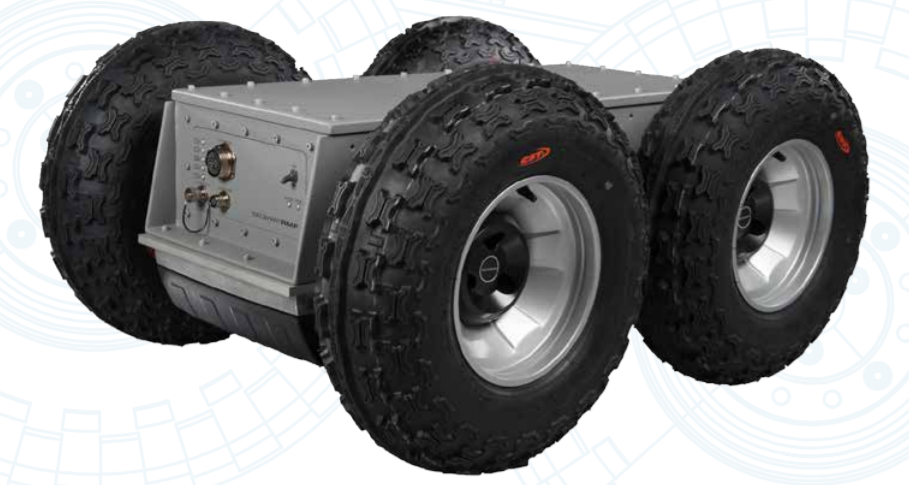 |
 |
The Segway RMP440 is in many ways effective for the goal we set for crowd control management. The robot is powerful, can drive fast, though rough terrain, lasts long, is strong, and most importantly: it is flexible. It can be mounted with waterguns, shields, guns or any other tool needed for crowdcontrol. Also, the cost is relatively low since the design does not include really advanced hardware. This relatively low cost is important: When multiple robots are purchased and then set up to connect to each other, these things could be driven by an autonoum program that navigates multiple of these robots simultaniously, performing known crowd control techniques for optimal crowd control. Since the control software is already written, it would only have to be modified and adapted for autonomous control.
Endeavor Robotics Kobra
The Kobra from Endeavor Robotics is like the Segway RMP440 an off-road flexible transportation robot. From their specification sheet:
The Kobra was designed to provide unmatched strength, power and payload support in an easy to operate robot package. Kobra has a lift capacity of 330 pounds (150 kg) and integrates numerous payloads to expand your operational area. Kobra can reach over 11.5’ feet (3.5 m), easily climb stairs, fit through doorways or down aisle-ways and store or deploy directly from the back of a small 4x4 vehicle. Able to achieve sustained speeds of 8 mph (12.9 km/h) while carrying 150-pound payloads, the Kobra maintains mobility on rough terrain in all weather conditions.
It can climb 55 degrees slopes, even steeper than the Segway RMP440. It also comes with four cameras, radio repeater compatible with the Endeavor Robotics software, and can be expanded with multiple accessories, sensors and disruptors (guns). Also it's runtime is 10 hours at operating conditions.
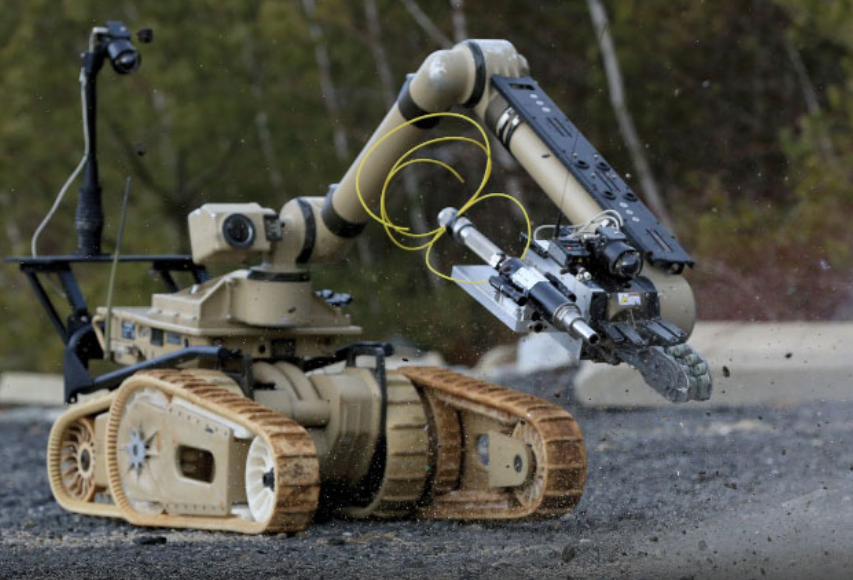 |
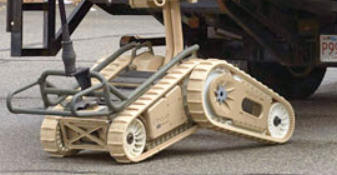 |
What makes this robot especially viable for our goal is the special caterpillar capability illustrated in the figure on the right. The robot has four caterpillars which can move independently. This results in optimal grip on all terrains, can deal with sudden changes in elevation (such as sidewalk curbs). It also enables for flexible movement and zero radius turns.
Evolutionary Artificial Potential Field
This method of robot control focusses on single robot control, but is probably a good option to expand for multiple robot control. The Evolutionary Artificial Potential Field (EAPF) method in general deal with motion planning that includes two different but complementary tasks: plath planning and motion planning. Path planning is responsible for generating a set of positions in the workspace that can drive the robot from it's initial position to the target position. Motion planning takes in account the path plan, but translates this to how the robot should actuate this path.
The EAPF is actually an optimisation of the Artifical Potential Field (APF) method. The APF method is illustrated in the figure below:

The robot in this figure prefers low rather than high potential, thus moves from the right to the left meanwhile avoiding the repulsive pillars. This method seems fine, however there is a massive drawback: the robot could be trapped in a local minimum of potential and get stuck. The problem is the robot checks the potential locally, and when it has navigated to a minimum it has no way of knowing how to proceed since locally, the potential is worse in every direction. This is illustrated in the APF Local Minimum figure.
It also turns out the system has difficulties in dynamic situations where obstacles change position or suddenly appear.
To solve the minimum problem of APF, EAPF was designed. EAPF attaches a cost to the potential. The EAPF method then tries to find a path to the goal that minimizes this cost. Only information on the position of the robot, obstacles and the goal is needed for this method. This way, a global planning is implemented to solve the local planning issue of local minima.
In the paper Optimal Path Planning Generation for Mobile Robots using Parallel Evolutionary Artificial Potential Field cited in the sources chapter, an even better method is proposed which uses the EAPF and adds Generic Algorithms to improve the path planning for dynamic environments with less computational power and a bigger workspace. Experiments in the paper show some promosing results shown in the figures below. The most important thing is that it can handle a dynamic environment, since the crowd control robots will experience this; there is no predefined map of the situation.
 |
 |
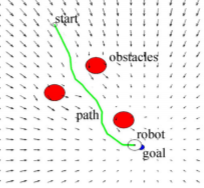 |
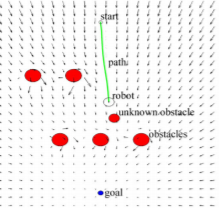 |
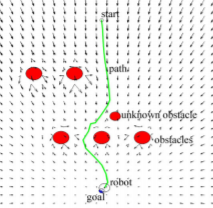 |
Crowd control technique
In the US Army Field Manual, different crowds are described on which to use different tactics. The Manual describes 3 crowd types: Public disorder, Public disturbance and Riot. With Public disorder being non-violent crowds, Public disturbance is where crowds start chanting and singing collective opinions. Some individuals will disturb the normal flow of things. A riot is the most extreme type of crowd, where crowds turn violent and actively try to defeat authorities and the controlling force.
For the control of a crowd, it is important to know it's type so control forces can react accordingly. To identify it's type, background information is needed. An assesment can be made by asking questions:
- Who are they? What is the identity of the crowd? Are they strikers, ethnic factions or social protesters?
- What are their goals?
- What are they capable of doing?
- What are their traditional behaviors?
- When and where will they assemble?
- Where will they go?
- What are the possible targets of violence?
- What is the worst case scenario?
- When and where will they disperse?
Knowing these questions is essential to decide on the tactic to control the crowd with. Too offensive can react to unnecessary violence, whereas too soft can react to an out of control situation.
For a public disorder, often it is enough to stand by and watch for disturbance. Public disturbance and riot often needs more advanced tactics. First of all, when a riot is started, it is important to deter people from joining or leaving the riot. This by for example extensive patrolling, or proclamate the illigality of the riot. Alert, agressive patrolling of the disturbance area deters the gathering of crowds, it also allows for information to be collected, and it creates the psychological impression of the control force being everywhere at once. The use of vehicles provide adds to that effect: The control force is better equipped than the crowd. Varying patrol routes and times keep lawbreakers from being able to pick a safe place or time to act. Proclamating the illigality of the riot makes people aware of the individual and how he is acting illigal. In a crowd, a feeling of shared responsibility causes people to behave different compared to when people are aware of the responsibility they themselves have. Making people aware of themselves and the illigalities they do by proclamation can stop this shared responsibility and deter people. Also warnings can be verbally proclamated like warnings of lootings: "During a disturbance, criminal activity is at it's peak. Your house may be getting looted now, return to your homes!" However, to really try to control the crowd, forces have to either disperse, or contain the crowd.
Containment is the process of limiting a crowd to the area they are presently occupying. It is a suitable option when the crowd must be prevented from spreading to surrounding areas and communities. Perimeter patrols and barriers have to be set up to contain the crowd. However, containment has to be acted upon with caution, to avoid the "fight or flight" syndrome common to people feeling trapped with no escape. Containment contains a lot of coördination. Barriers have to be set up at specified locations. Vehicles or forces have to be traveling at close interval in formation. Dispersion is the process of taking deliberate actions to fragment an assembled crowd in order to prevent the destruction of property or prevent injury. Dispersion is done by proclamations, show of force and moving in crowd control formations. The difficulty of dispersion is channeling the dispersion route. The dispersed crowd should preferably take a chosen route where the crowd can safely and calmly leave the area. Dispersing crowds into wide-open areas for example is unwanted since a new gathering can occur. The crowd should be kept moving, but not too hurried to avoid panic.
This projects opts for Civil Disturbance Formations executed partly by robots. Especially the front of each formation should be operated by robots to minimise damage to the control force. There are different formations (A,B,C, are the squad members, other signs are leaders etc. in the figures below):
- Line formation is the most used formation because it's offensive and defensive applications. As offensive, the line is used to push or drive crowds straight back across an open area or street. Defensive to hold the crowd or deny acces to a certain area.
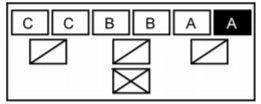
- Echelon formation is an offensive formation to drive crowds away from buldings, fences and walls.

- Wedge formation is an offensive formation to penetrate and split crowds into smaller groups.
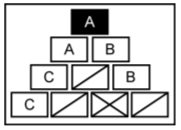
- Diamond formation is a defensive formation that offers all-around security when in an open area.
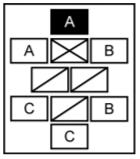
Ideally, the robot designed for this project would be able to execute these formations. The robots should be communicating with eachother sharing location and sensor information to execute this.
Concept Design
Police interface
To give an idea of what is envisioned to be the input from the user side of things we designed a mock-up interface to visualize this.
The police can command the robot via a computer system that instructs the central control what to do. Also feedback from the robots is given, or can be requested. A concept of the interface is given below. In the propesed interface a simple interpertation of the data that needs to be relayed is shown in the view. The view should leave room to instruct where the robots should go while maintaining the autonomy of the system.
 |
 |
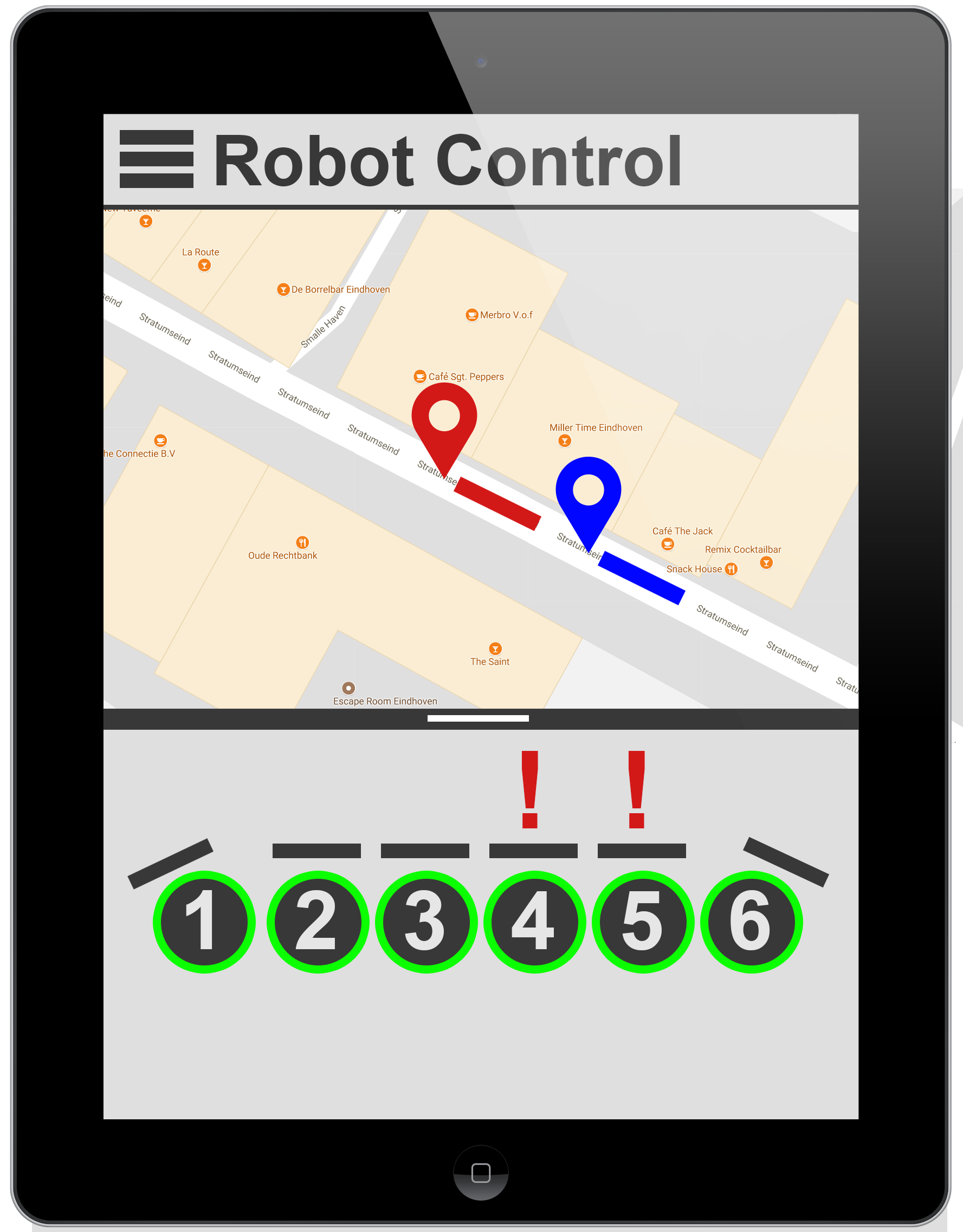 |
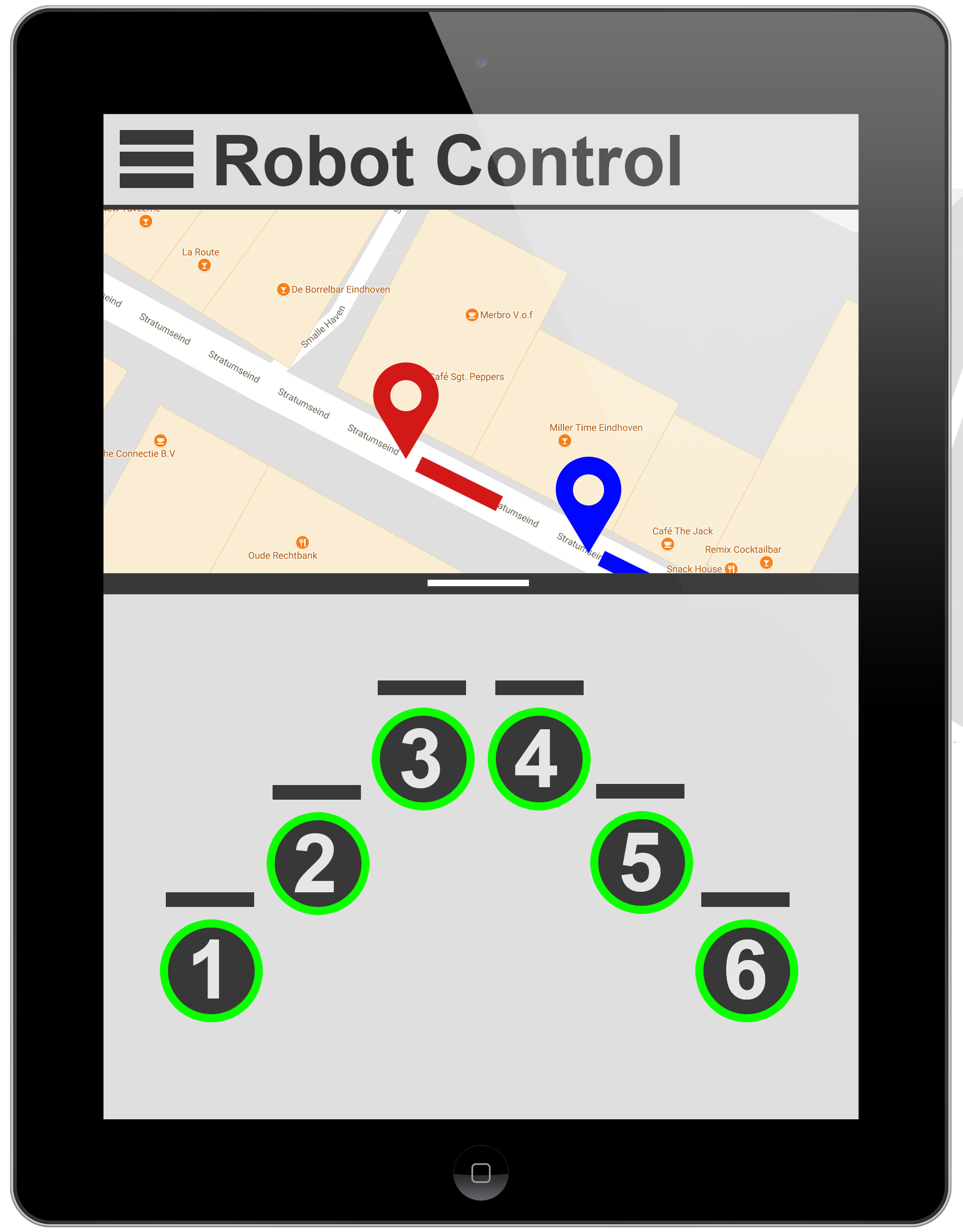 |
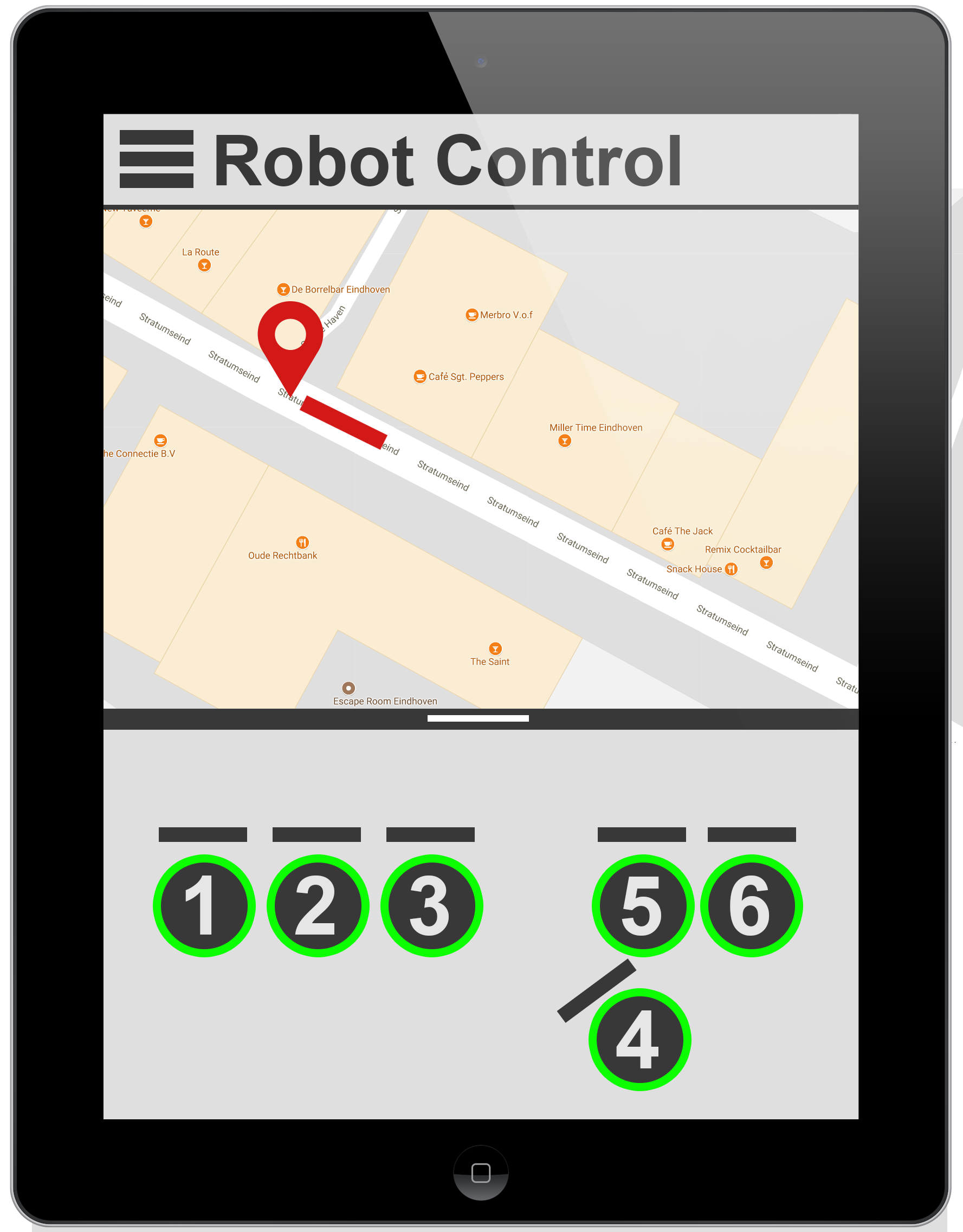 |
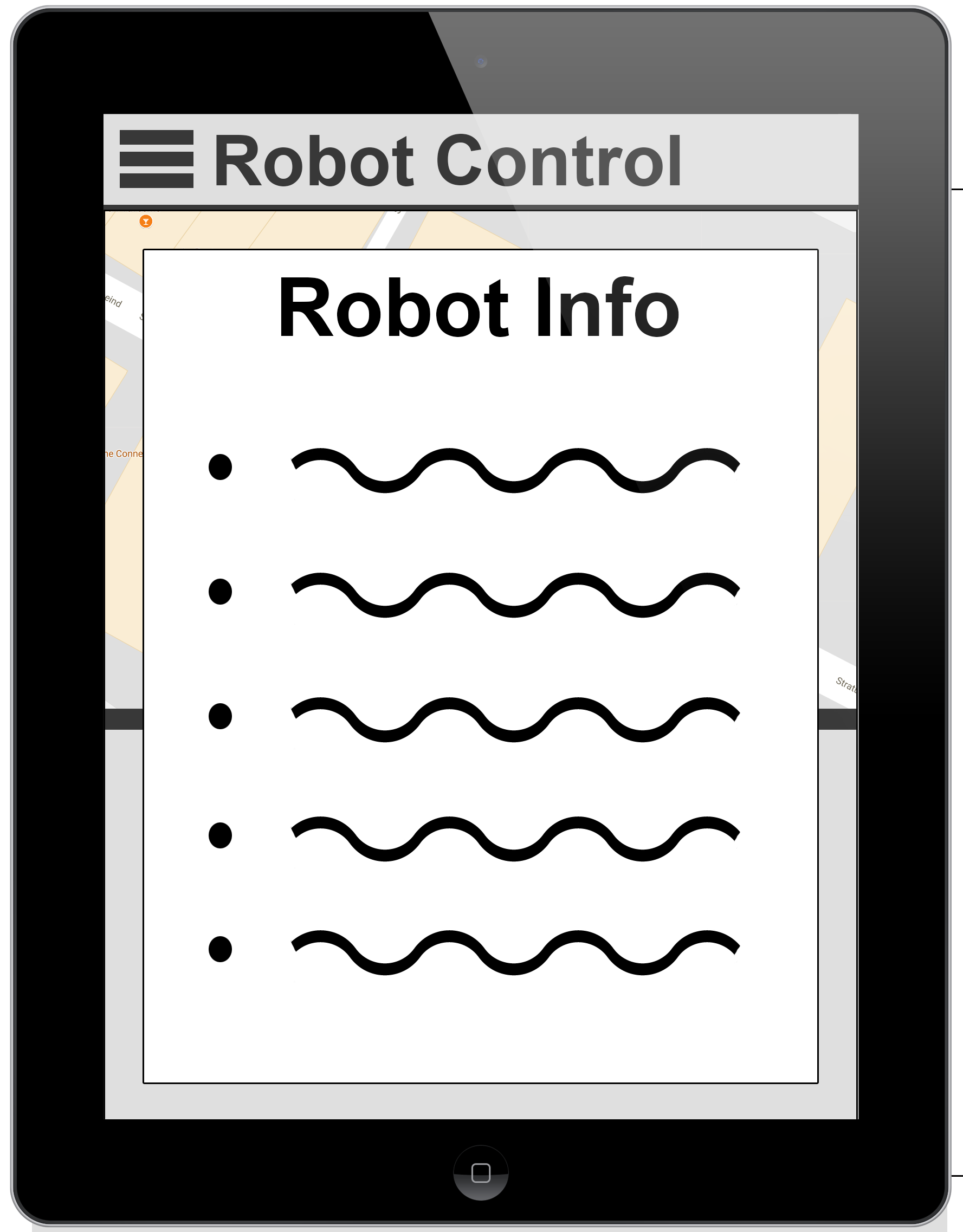 |
- In the first figure, the red arrow indicates where the formation is on the map. A red line indicates the direction the formation is facing.
- In the second figure, the blue arrow is the location commanded by the police of where to go. It can also be seen that robot 4 is in emergency state. It stopped actuating. Info on why can be requested by double tapping on the robot. Info is presented in a popup as shown in the last picture. Robot 5 has an issue and is trying to solve this via one of the feedback loops.
- In the third figure, it can be seen that robot 4 and 5 are being pushed. This is indicated with the red ! mark. It can also be seen that the police commanded that robot 1 and six have their shields turned slightly outwards of the formation.
- In the fourth figure, it can be seen that the police commanded an alternative formation.
- In the fifth figure, the police wants to do an arrestion or open up the barrier of robots for some other reason.
Robot Communication
Flowchart
We designed the flowchart to provide a rudimentary overview of steps the robot should pass through in its decision process. It gives some guidelines as to which checks are required to advance to the next set of observations to be done by the robot. Most of the checks are done to make sure the robot can interpret its surroundings properly. Making sure it functions properly and safely.
The robot
It starts of simple checking if the robot is still upright all visual and movement data’s perception can depend on this. If the robot has fallen down the cameras’ view is turned about and if the robot is tilted, it cannot move thus disabling its functions.
The next step checks for the robot’s pressure sensor behind the shield. This is done before the movement is checked to make sure the robot can detect if it is being pushed back by the people it is supposed to move. Following the check of the pressure sensor the robot will thus check if it is on track following the path set out for it moving in the pattern. When this is not going well the robot should be aware if it can still move properly because if the engine or propulsion fail the robot becomes incapacitated. If the propulsion works properly the robot will check if it is being pushed back and if so reevaluate its engine output. Making sure that even when under stress of people pushing it the robot is able to advance and deliver power proportional to the forces pushing it back. When there is no pressure on the shield or the robot simply does not know the robot should attempt to output more power and see if this improves the situation. If so, continue and if not assume there is an invisible object directly in front of the robot. These two options ensure that the robot is resistant to blocking it might not have been able to perceive and surfaces it cannot get proper traction on.
If the robot can actually drive there is a check that when it is moving the robot can move its shield if necessary. This might not lead to immediate problems yet can prohibit the robot from performing the orientation needed for certain formations.
Both cameras, depth and IR, are both checked for the same fails but record different data. The cameras can be sprayed or covered, or smoke bombs might be used by the crowd. In both situations the safety of the people being displaced by the robot cannot be guaranteed thus the robot should wait, deal with it or shut down. In the case of the camera being impaired by smoke the robot should wait and notify the responsible officer why they cannot yet proceed. When the smoke clears enough the robots will proceed as planned again having some guarantee on perceiving its surroundings. When the camera is covered the robot should try and wipe it clean using the cleaning solution. If this improves the visibility the robot should continue its efforts and if it does not improve at all or sufficiently enough it should report being disabled. This all again to maintain situational awareness guaranteeing the robots’ functionality. When the camera is not functioning at all, i.e. not sending data the robot should report its incapacitation. When the camera has been determined to be functioning the depth camera checks the surroundings for obstructions and maps the people it can see. The obstruction data is then extended with any fires detected by the IR-camera and the human signatures of the depth camera are cross referenced with the IR-camera. The resulting map of people is checked for their height determining whether they should be seen as an obstruction or not. (mapping format explained bellow)
When this is all done the robot connects (if possible) to the controller and sends the data and updates with what it receives back.
The controller
The controller checks if the goal for the formation has been changed. If so its goal paramaters need to be edited accordingly. During a cycle the robot receives maps from the robots. It will then check if all active robots have sent their data. If it has not happened consecutively for a given boundary of times the controller will simply assume the previous data to still hold. If it happens more often the robot will be presumed to be lost and it will from now on be an obstacle. If a robot respondes that has been considered lost the system will try to reïntergrate it. The maps are then concatenated and the goal and available space are used to derive an optimal path if possible. If these are found the robots are updated. But if it is not able to keep going an error is sent and the robots await a new goal.
 |
 |
State diagram
In reality, robot operations almost inevitably fail to go according to plan. Events may occur have not been envisioned beforehand, and thus the robot might not be capable of handling such situations. Or the robot could encounter mechanical, electrical of software problems of its own hindering in its proper behavior. Sensors and actuaters can misbehave or even break down. In a flow chart, a nominal plan of action can be acurately and clearly described. However, fail states are harder to describe in the format. This is where the state diagram comes in. In the state diagram, different problems can be described, and tell the user/robot what to do. It is a clear method because the robot can asses in which state it finds itself in, and can plan action according to the state's conditions.
The state diagram for our robot can be seen in the figure below.
 |
As can be seen, the "not moving" and the "moving" states are the base states. The "moving state" has disconnected condition arrows since they have the same exact condition arrows as the "not moving" state, for graphic purposes these are left out. In these two states, the robot is:
- Sensing
- Sensing means that it is processing sensor information from all the robots sensors like the camera, IR camera, gyroscope and shield force feedback.
- Mapping
- Mapping means that the robot processes the info from the sensors into an obstacle map which it then sends to the control unit (mapping format explained bellow).
- Connecting
- Connecting means that the robot is actively communicating with the control unit.
- Checking goal
- Checking goal means that it requests a goal from the control unit to persue.
- Checking location
- Checking location means that the robot compares it's location to the location the control unit thinks the robot is at.
- Actuating
- Actuating is rotating the robot shield or driving.
From the base states, the robot can branch into different states and feedback loops to solve problems faced during operation. The first situation is that the robot is turned off by the police. It is commanded shut-down, it then goes via the shut-down state to the robot off state. At start up it goes via start-up to the not moving state.
Should the camera malfunction, a camera error is given. It goes to the RGBD(epth) Camera Malfuction state. There it checks if there is signal to the camera. If not, it tries to find it. When there is no signal, the camera is assumed to be critically broken. Without camera the robot is unsafe for operation and thus put into emergency mode, which stops the robot from actuating. It could occur that the camera is painted on or coated with a piece of cloth to obscure camera vision. Light levels and depth levels are checked. A cleaning solution is applied. If the cleaning solution improves vision, it is applied again untill vision is good enough. If the cleaning solution fails, the robot is again prevented from actuating. The camera could also be obscured by smoke. Smoke has a homogenous color, thus when this homogenousness is measured, the robot will wait untill the smoke is cleared for safe driving.
When there is fire, the IR will pick up on an exceedingly high temperature. The fire is then noted as obstacle on the robot's road map.
When the robot's connection with the control unit is gone bad, the robot tries to reconnect. If the connection is totally dead, the robot will be prevented from actuating. If the connection is not totally dead, the robot will try to connect untill the connection rate is acceptable.
It could also be that the robot is pushed over by rioters. The robot notices this by checking the gyroscope. The robot then is prevented from actuating and the police is notified.
Also, the robot could be in the wrong location. This could happen because of no actuating power or the robot is obscured and prevented from moving by an obstacle or people pushing the robot. It is checked if the engine is working or if it is being obstructed. If it is obstructed, it is checked wether people are pushing or not. When it is being pushed, it gives a signal to the police officer. If it obstructed, an object is put in the map so the control unit can plan an alternate path.
Mapping

The data collected by the robots is mapped in a field to represent its surroundings. In the image to the right we see an abstract view of such a mapping. The singleton robots view (top pair) might only see the front of an object leaving what is behind it ,the blank area behind the object relative to the robot, uncertain. But when the robots join their maps a more precise description from multiple angles of the obstacles they encounter is given. Leaving less uncertainty to interpret. When considering that multiple robot from different viewpoints will be describing objects the controller can, using this joint dataset, more accurately describe a path around obstacles. In the final image the controller receives a dataset from a large set of robot revealing the vision we have for the way we the system utilizes the benefit of having multiple agents. This is only an abstract view of a single object so the total benefit might not be as significant in a more cluttered environment but unless the area has surveillance this seems to be the best option.
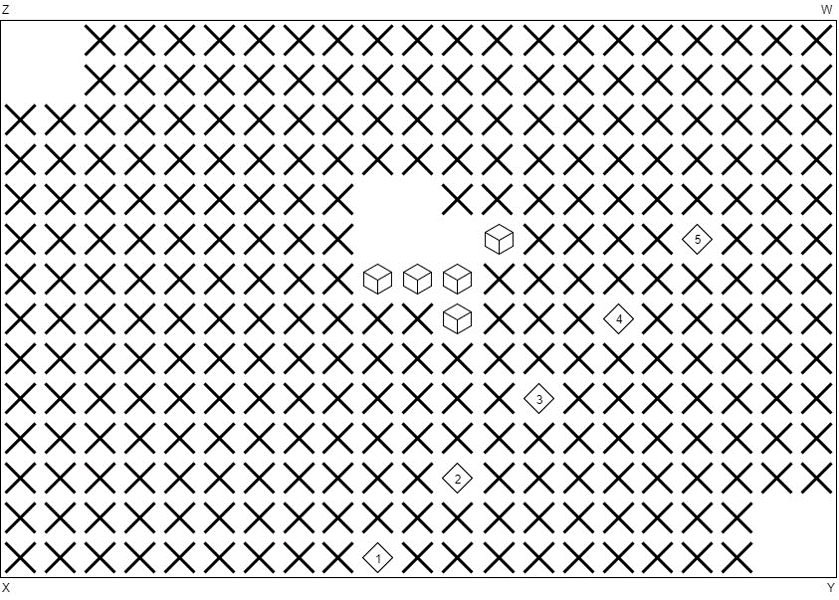
Validating concept
In our requirements there are three requirements of the whole robot that have to be met by our part of the design. These are the capability of situational awareness; capability of controlling by a tablet and the withstanding of extreme forces. The first one is the most interesting as it requires a lot of knowledge, first of all it depends on a lot of input and this input must be converted to a output that can be used for decision making. Our project focuses on this decision making. One of these decisions is about obstacle recognition, we came up with a solid system to detect obstacles, this requirement will most likely be met. If the rest of these requirements have been met, our state machine will fulfil all the tasks and actions it needs. Than about the control capabilities, there is an interface made as example for controlling the robots. In this interface, the police officer can place every robot in every place possible, so it can form every formation that can be thought of. In our interface there is no possibility to set the movement speed, this speed is decided by the control unit in the making of the trajectory. Though it can be changed when people are pushing too hard or people are getting choked in the crowd. Which leads us to the emergency button, this was required and it is an important aspect of our concept. Also the scenario of using this function is explained as the robot must be controlled autonomously as fast as possible. Thus we can say we met our requirements.
USE case treated
To demonstrate what the robot exactly will do a USE case will be treated, in this piece every step will be explicitly explained. It is the following USE case: The riot is in a starting phase, distance between the robots and the crowd is ten meters, people are talking to each other and some of the members are throwing some bad language to the police. In the middle of the crowd a woman is injured and needs first aid but the crowd won’t let them through.
The police decides to help the injured woman, so there must be a clear path for the first aid to get to the woman. The police officer sets the goal for the six robots at the location of injured woman and sets the line of robots in a v-shape formation on the tablet, with the point towards the crowd. Shields are adjusted so that there are no gaps between them by the police.(1) The robots have already mapped the environment and a trajectory is sent to them. They start driving towards the crowd, one robot encounters a street light and evades it with the pre-set trajectory. After a few seconds the robots are reaching the crowd, most of the crowd is moving away for the robots, but some other crowd members throw a smoke bomb in front of the robots. The robots stop as the hue is not right, it stays homogeneous for a while, after a minute the smoke has cleared up and the robots sight is totally restored. The robots then recognize some new obstacles with the depth camera, when checking with the IR-camera, the robots notice that there are people standing in front of them. These people do not want to let the robots through, so when the robots reach these persons, the persons starts pushing against the robots. The robots notices it is not in the correct position according to the trajectory and time. After a second the robot is still not closer to the correct location, so it checks the motor power, which is correct. Following the state machine, the robots are checking the force feedback and the two robots in the middle notice a high force feedback, which means they notify the police. The police officer changes the formation by sliding the two front robots aside,(2) an arrest team comes through the resulting gap and arrest the crowd members for hindrance of a police task. After some people are arrested, the other rioters got afraid and stand back from the robots, the robots continue their trajectory and they reach the woman, the goal is set a few meters further as the police officer made a slightly off approximation. The robots recognizes a person, but is lying down on the ground, so it is below 70 centimeter, the robots sees the woman as an obstacle and are going around her. The first aid reaches the woman and take her to an ambulance. To restore the rest in the crowd the police officer sets the goal for the robots ten meters in front of the crowd, and the robots return to their first position.(3) The woman is treated and some rioters are arrested for hinder.
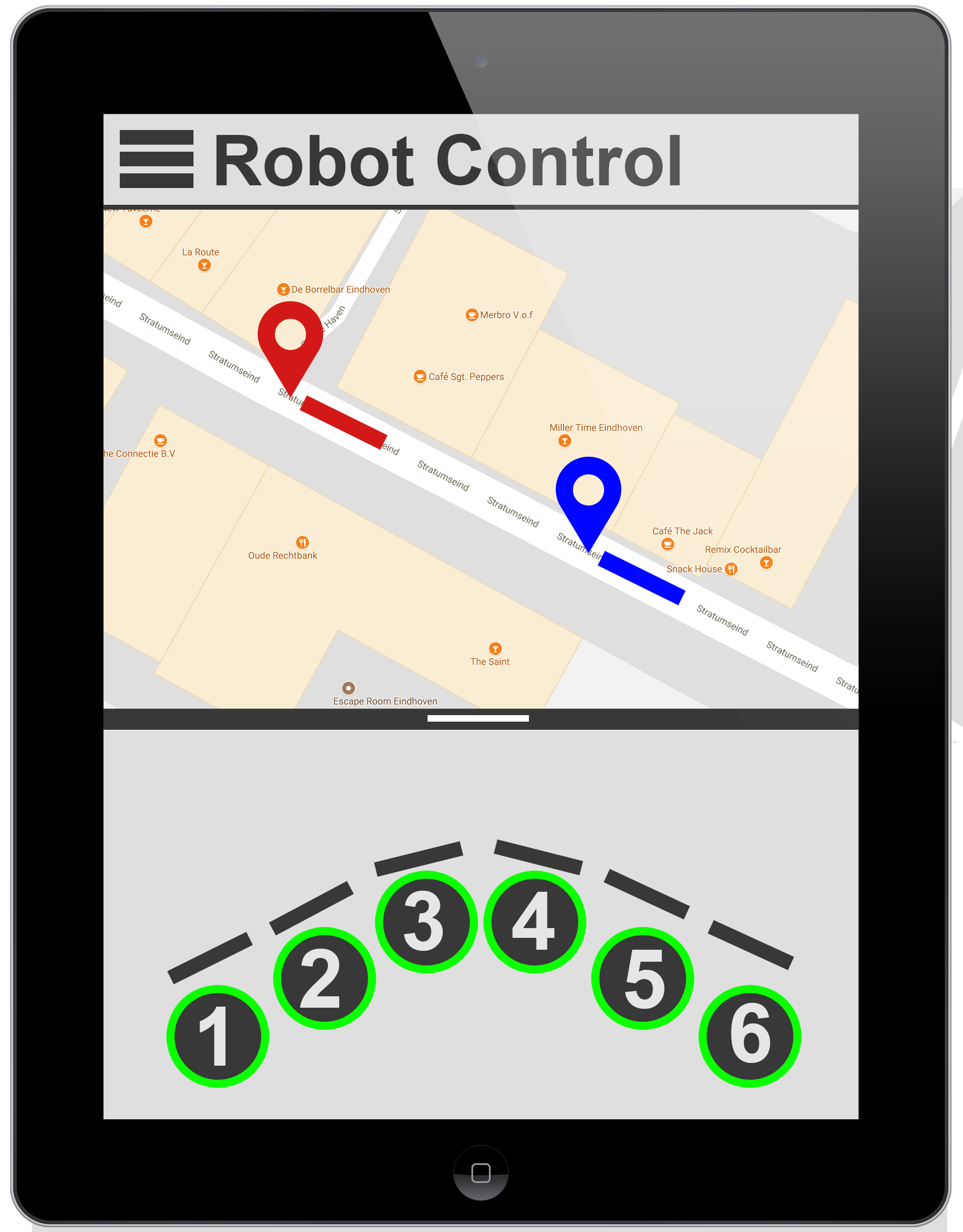 |
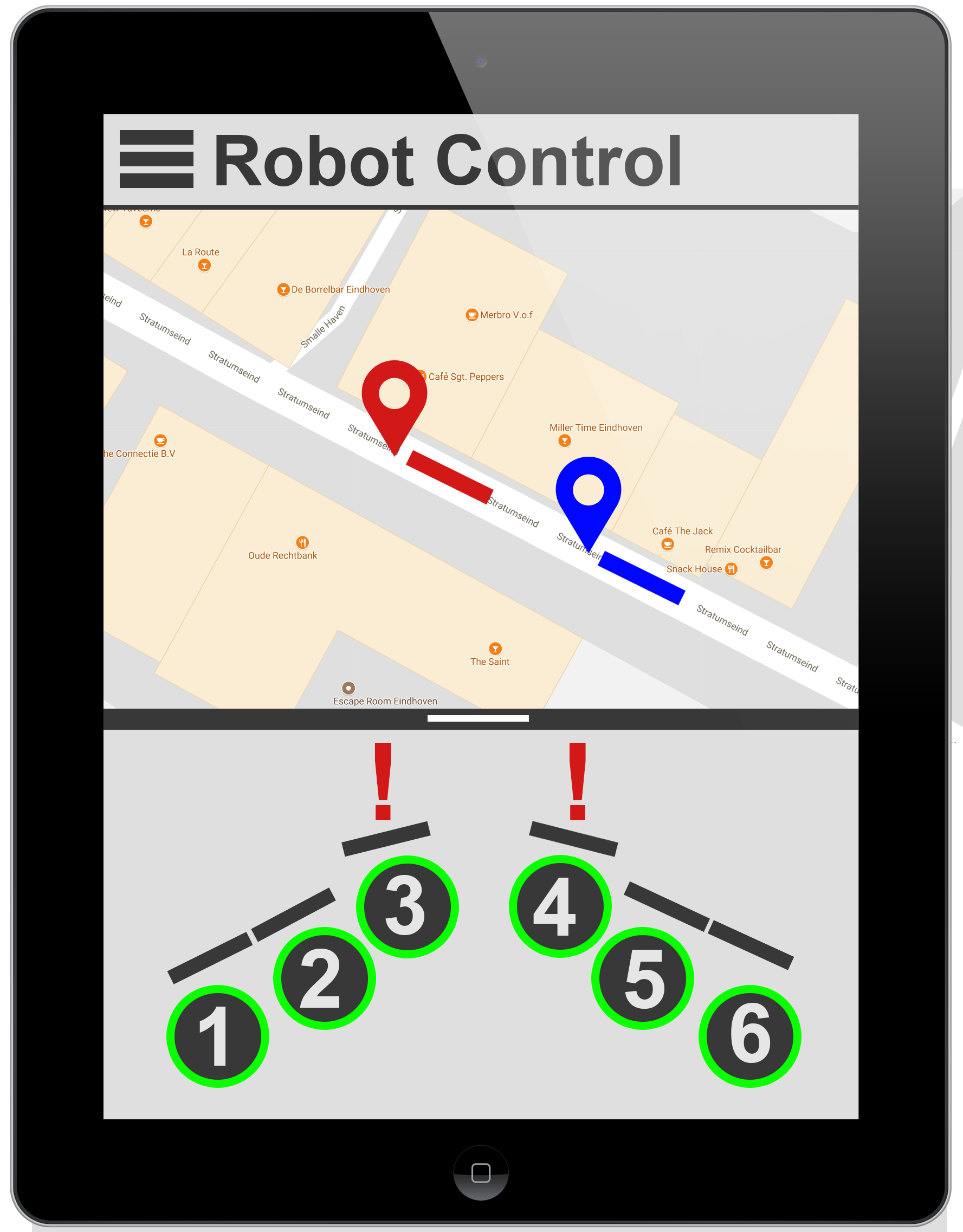 |
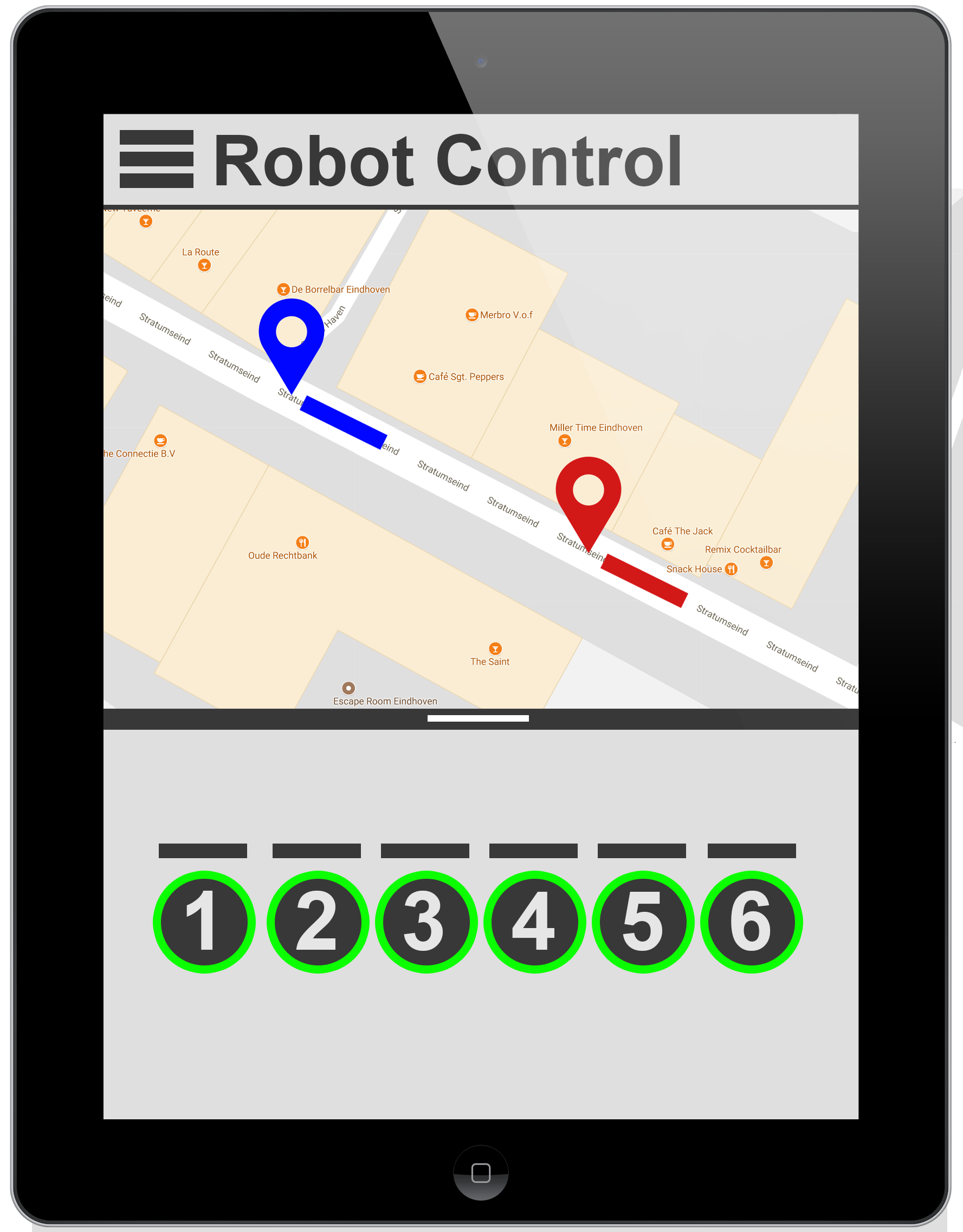 |
This is one scenario, the other USE case mentioned is as follows: The riot is in a critical phase and in the middle of the crowd there is a fire.
The fire is dangerous for the health of the crowd, especially when it is this busy, that is why the police decides to clear the way to the fire, this is done by using a line formation.(4) The police officer sets the strategy, shield direction and the goal of the robots. While the robots were at rest, they already started mapping the area. The first obstacles are mapped and they know where the crowd is holding up. The control unit sets out a trajectory for each robot and they start following this trajectory. It doesn’t take much time and they collide into the crowd, the crowd immediately starts pushing and one person sprays the robot with paint. This robot starts the cleaning procedure and notifies the police officer it is not functioning complete. After a few wipes it notices the cleaning procedure does not gain any progress and notifies the control unit and police officer it is not functioning anymore. Because the robot already notified his incomplete functioning a reserve robot is placed behind him, the broken robot stops his trajectory and the reserve robot takes over. On the other side of the line, robots notifies the police of a high force feedback.(5) The police sets the line such that the arrest team can get through to arrest the rioters for hindrance of police tasks. This goes on until they reach the goal, there the IR-camera detects a fire, it sees the fire as an obstacle and goes around it. After that the fire brigade has the room to extinguish the fire and the riot is still under control. The robots stay at their goal and wait for further instructions.
 |
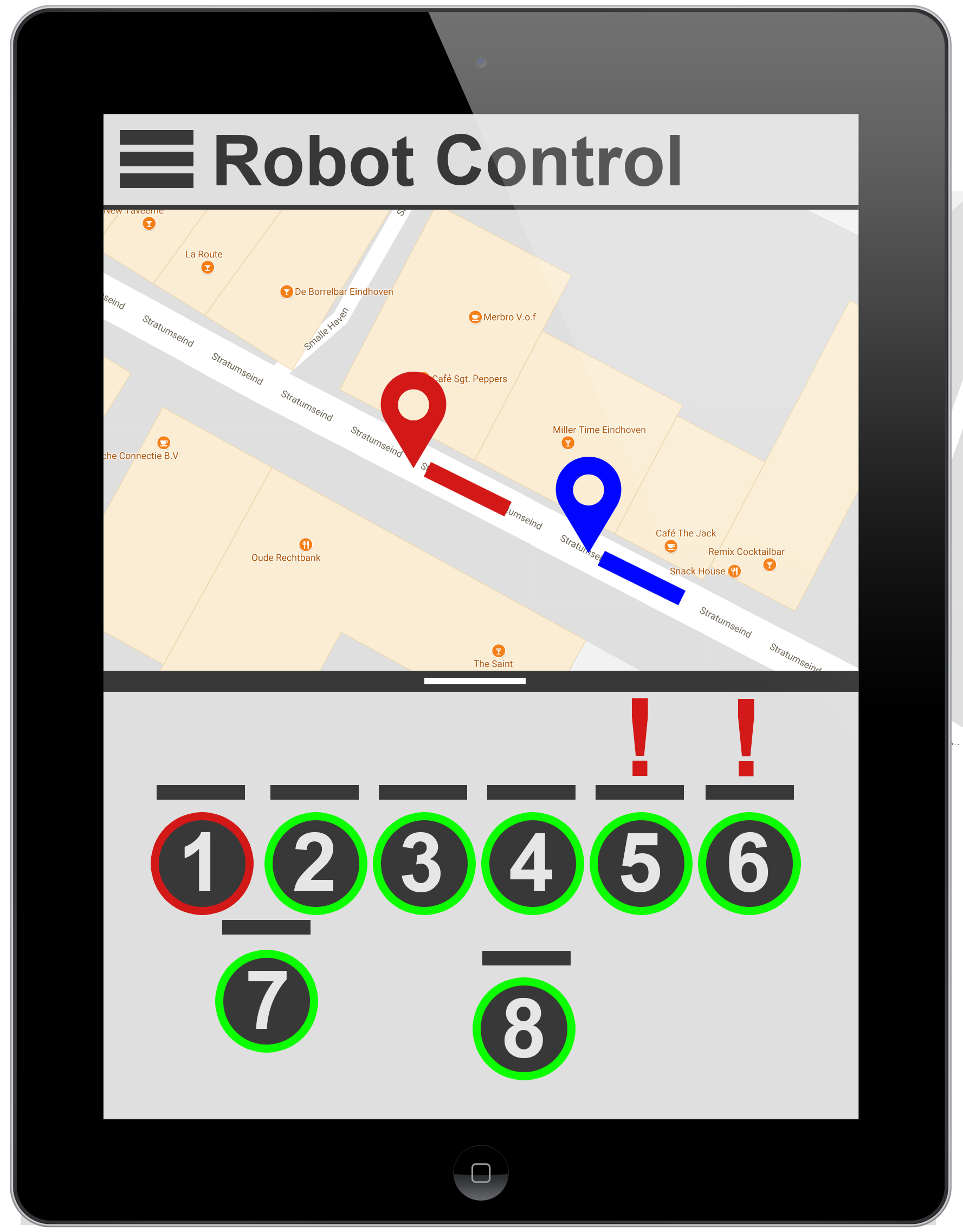 |
Stakeholder interview
The interview with Paul Moss

We interviewed Mr Paul Moss of the police academy. His function is process communicator and he is responsible for the realization of research and education there. Furthermore he is an active member of the Dutch police force and a peloton commander of the Dutch riot control. He was on duty during multiple riots with the most extreme one in ‘s Hertogenbosch, the ‘Pierre Bouleij’ riots which took four nights and got national and international media attention. He spoke about the two different variants of riots. The ones that can be predicted, like after a soccer match when hooligans turn against the police. Those evolve very quickly but don’t usually take longer than 4 hours. The other being those that cannot be predicted. When talking about the escalation of riots, he named the example of what happened at the Feyenoord stadium, where supporters were angry at the board of the club, which were situated at the Maasgebouw. The M.E. anticipated what was going to happen and held formation in front of the Maasgebouw. Officers tried to calm the crowd down by communicating with the rioters. Nevertheless the frustration grew and got the better of the supporters, turning violent against police. The danger in these situations is for minor and serious injuries on both sides, police officers and rioters. The police can be harmed by projectiles like rocks, or physical violence. The other side gets hurt by batons, or charging policemen, horses or dogs. For our robot the charging would be very interesting so we continued on that subject. He explains the process of charging starts when the crowd gets too close at the line of policemen. The policemen are urging the crowd to leave, however if the crowd does not leave, the line starts moving up slowly, pushing the people backwards. When the peloton commander notices this does not achieve the desired goal, he decides to make a charge. At that point the line mover forward slowly in combination with the threat of being hit with the baton. If this again does not have the desired effect the decision can be made to speed up for threats are not working. Officers are forced to drive the crowd back using force, even to the point of using mounted officers. This goes on until the peloton commander gives the signal to stop the charge. In special cases, when charges have no effect, a water cannon can be used to disperse the crowd. This needs permission from mayor of the city. The peloton commander has control over when such a tool might be deployed. Also other agents like dogs, rubber bullets or tear gas are allowed to be used according to Dutch regulations.
Having more information on how riots grow and how riots are handled, the concept of the autonomous robot idea was described. Mr. Moss his first reaction was about a riot control vehicle in Ireland or North-Ireland where police busses were equipped with guard screens on the side of the vehicle. This vehicle are used to both push people back, and have a protective screen for officers against projectiles. Wondering if our robots would fulfill a similar role, we explained our robots are a lighter more versatile platform more akin to the frontline of M.E. officers with shields. He then elaborated upon the spectrum of force applied by these officers. The action of pushing that the robot would need to perform would be classified as a low violence solution. There is no research being done on such applications that he knows of. Whereas high violence solutions like batons, dogs, tear gas and water cannons are actively being looked into to be expanded upon with for instance rubber bullets. He really liked that this new concept for low violence is being researched and felt the functionality could prove to be useful.
To synchronize our concept with the wishes of the police, we started talking about the requirements our robot should have, he then summed up the following points: Functional in a diverse set of situations, for example heavy rainfall or snow. Struggle solid (“slag en stoot bestendig”), it must endure some serious aggression to the extent of what a group of violent people can apply. Intuitive controllable and usable; operational for the full duration of a riot. Some riots can take only a few hours, for example soccer riots. While others can take up many hours spread across multiple days. These are mostly riots in suburban areas. A camera for recording misconduct in front of the robot line.
Finally some general thoughts and opinions of Mr. Moss is asked. Firstly it was asked how he thought rioters would react at the concept of a robot shield barrier. He immediately argued that people at first would be hesitant of how to react. This might cause people to react violently and that therefore communication at the frontline with rioters would be of utmost importance. He then spoke about the effectiveness of such a system. He thought officers would be offered improved protection against projectiles and other violent altercations. Furthermore it would be easier to manipulate crowds. However he did say that in full scale riots the robots would probably lose their effectiveness since there would be too much violence and chaos. The major safety concern Paul had in our concept is about choking. When a crowd gets pushed back, the back of the crowd has to be able to leave the area. If this is not possible, a choking hazard arises. With large crowds it is often hard to see if leaving the area is possible. This is more a tactical problem than a problem then a robotic problem but it should be kept in mind. Afterwards we showed him our user interface, he immediately came up with another use for our robots, the situation where the crowd has to go through the police, but cannot do this in large numbers. Here our robots could stand as a funnel and let them through. We then asked about what should happen, should there be an emergency for some reason. He argued that if the emergency is not a huge problem, robots should stand their ground. If otherwise, police forces would have to take over and do the same themselves. The last question was asked about a recent case, the one in Rotterdam on the 7th of May 2017, when disgruntled Feyenoord supporters needed to be removed. We wondered how our robot could have changed the situation in his sight. He thought it would be a less violent solution, it would have given a safe signal to the crowd. Next to that, there are less people needed to control the crowd, who could be used on another place making sure the crowd leaves safely. He definitely saw chances and opportunities in our concept and would like to see the end result.
Stakeholder requirements summary
To summarise the requirements we determined from the interview:
- Easy to setup and use.
- Able to operate for the full duration of a riot.
- Portable for different locations.
- Weather resistant, able to perform properly during for instance snowfall or heavy rain.
- Robust, resistant to all manner of abuse directed at the robot ("slag en stoot bestendig").
- Able to monitor its surroundings using camera's.
- Able to hold their formation even when the system is heavily strained.
- Enable communication with the people in front of the robots.
Conclusion
Results concept
For this project we had two main objectives, the first was about helping the police out as they had too less manpower in situations as riots, the other was about creating a safer situation, thus less violence and victims on both sides. From the feedback we got in the stakeholder interview, we have determined that the robot would definitley decrease the manpower needed in riots, mr. Moss even thought about resituating these police officer to other tasks in riot control, making sure the crowd safely leaves the riot. Futhermore, he said it would be a less violent solution to riot control, it gives the right signal to the crowd. Thus our concept will enhance the safety of all participating parties in the riot. Next to that, the USE cases showed that the robot worked fine in difficult situations, there are no victims in those situations either. This is due to our concept, which has a low violence threshold, for this reason mr. Moss liked our idea, as there is a lot of investigation going on about riot control with a high violence threshold, he thought this could change the riots in a postive way.
Further investigation
As we did not have the time to design the entire robot, there is still a lot of work left before the robot can be utilized. The requirements we set cover the functionalities it should have. Mostly mechanical mechanisms have to be researched yet. There is also a lot of work left in the research of robot human interaction as crowds/people are not used to robots thus their reactions might be unfavorable and should be dealt with. Furthermore there should be more research about the navigation technique, as our mapping mechanism is not tested yet and we don’t know how accurate this will be. Next to that, the accuracy of location determination has not been specified and could be looked into, this robot needs an accurate determination for holding the line and navigating through a street full of obstacles. After this research is done, a complete design can be suggested. This design should be tested in different situations. Then through optimizing and testing, the final design will be completed.
Sources
- Endeavor Robotics Kobra
http://endeavorrobotics.com/products#710-kobra
- Endeavor Robotics Kobra Spec Sheet
- Segway RMP440 Spec Sheet
http://rmp.segway.com/downloads/RMP440LE.pdf
- PEAPF Navigation technique
https://link-springer-com.dianus.libr.tue.nl/content/pdf/10.1007%2Fs10846-014-0124-8.pdf
- Crowd Control Technique
https://fas.org/irp/doddir/army/fm3-19-15.pdf
- Gustave Le Bon, The mind of Crowds
http://www.gutenberg.org/files/445/445.txt
- Freud Group Psychology
http://freudians.org/wp-content/uploads/2014/09/Freud_Group_Psychology.pdf
- Social identity theory and other social theories
https://www.simplypsychology.org/social-identity-theory.html
- Irrational riots
http://news.ku.dk/all_news/2013/2013.4/riots_create_irrational_behaviour/
- Crowd behavior research Groningen
http://www.rug.nl/research/portal/files/14565232/02c2.pdf
Papers and articles:
- Human Robot Interaction
- (1) Humanoid robots state of the art, and human reaction (book) https://link.springer.com/content/pdf/10.1007%2F978-0-387-85349-9.pdf
- Psychology of Rioting
- (2) Crowd action as intergroup process: Introducting the police perspective http://onlinelibrary.wiley.com.dianus.libr.tue.nl/doi/10.1002/(SICI)1099-0992(199807/08)28:4%3C509::AID-EJSP877%3E3.0.CO;2-C/abstract
- (3) Cops and Chaos: A Historical Examination of the Police Role in Riot Control http://www.tandfonline.com/doi/full/10.1080/19361610.2015.1069532?scroll=top&needAccess=true
- (4) Crowd theory and the management of crowds: A controversial relationship http://journals.sagepub.com/doi/10.1177/0011392113486443
- (5) Contemporary understanding of riots: Classical crowd psychology, ideology and the social identity approach http://journals.sagepub.com/doi/10.1177/0963662516639872
- Conflict escalation
- Riot Simulation
- (6) Analysis of a riot in Burnley http://www.tandfonline.com/doi/abs/10.1080/10439460410001674956
- Crowd Management
- (7) Interactive Control of Large-Crowd Navigation in Virtual Environments Using Vector Fields http://ieeexplore.ieee.org/abstract/document/4670099/